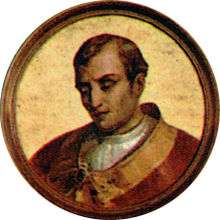Pope Donus
| Pope Donus | |
|---|---|
 | |
| Papacy began | 2 November 676 |
| Papacy ended | 11 April 678 |
| Predecessor | Adeodatus II |
| Successor | Agatho |
| Personal details | |
| Born | Rome, Byzantine Empire |
| Died |
11 April 678 Rome, Byzantine Empire |
Pope Donus (died 11 April 678) was Pope from 2 November 676 to his death in 678.[1] He was the son of a Roman named Mauricius. Few details survive about the person or achievements of Donus, beyond what is recorded in the Liber Pontificalis.
Reign
While Donus was Pope, he had the atrium, the enclosed forecourt of St. Peter's Basilica paved with large blocks of white marble, and restored other churches of Rome, notably the church of St. Euphemia on the Appian Way and the Basilica of St. Paul Outside the Walls.[2]
During the pontificate of Donus, Reparatus, the Archbishop of Ravenna, returned to the obedience of the Holy See, thus ending the schism created by Archbishop Maurus, who had aimed at making Ravenna autocephalous (independent).
During the reign of Donus, a colony of Nestorian monks was discovered in a Syrian monastery at Rome — the Monasterium Boetianum. They were possibly refugees fleeing the Muslim conquest of the Levant.[3] Donus is reported to have dispersed them through the various religious houses of the city and to have given their monastery to Roman monks.
He expanded the clergy of Rome with twelve new priests and five deacons. He also consecrated six bishops for various Sees.[4] One of these may have been Vitalianus of Arezzo.[5]
Relations with Constantinople at the time of Donus' reign tended towards the conciliatory. On 10 August 678 the Emperor Constantine IV Pogonatus wrote to Pope Donus, "the most holy and blessed archbishop of our ancient Rome and the universal Pope," hoping to attract him to engage in negotiations with the Patriarch of Constantinople and the Monothelites.[6] He ordered that Pope Vitalianus' name be put back in the Diptychs of those bishops in communion with Constantinople, an act which caused him a great deal of trouble from the Monothelites and the Patriarch Theodoros.[7]
Donus' pontificate lasted one year, five months, and ten days. He died and was buried in St. Peter's Basilica on 11 April 678.[8]
References
- ↑ John Moorhead (2014). The Popes and the Church of Rome in Late Antiquity. New York: Routledge. p. 198. ISBN 978-1-317-57827-7.
- ↑ Duchesne, Liber Pontificalis I, p. 348, who conjectures in note 2 that the church in question was not the Basilica, but instead a small church commemorating the parting of Peter and Paul on their way to execution. Mann, pp. 20-21.
- ↑ John Moorhead (27 Nov 2014). The Popes and the Church of Rome in Late Antiquity. Routledge. ISBN 9781317578260.
...the advances of Persians and then Arabs in the middle east that were responsible for the coming of Maximos to Africa and, presumably, Theodore of Tarsus to Rome, could easily have brought many more, such as the Syrian monks whom pope Donus discovered were Nestorians.
- ↑ Duchesne, p. 348.
- ↑ Jacopo Burali d'Arezzo (1638). Vite de'vescovi Aretini ... dall'anno CCCXXXVI sino all'anno MDCXXXVIII, etc (in Italian). Arezzo: Ercole Gori. p. 19.
- ↑ Delogu, p. 61 note 14: Dono sanctissimo ac beatissimo archiepiscopo antiquae nostrae Romae et universali papae...." J.P. Migne, ed. (1863). *Patrologiae latinae: 87: Scriptorum ecclesiasticorum qui in 7. saeculi secunda parte floruerunt opera omnia ... juxta memoratissimas editiones D. Mabillonii ... (in Latin and Greek). Migne. pp. 1147–1153.
- ↑ Baronius (ed.Theiner), p. 600 (year 677, no. 2). The restoration was ordered by the VI Ecumenical Council.
- ↑ Duchesne, p. 348.
Sources
- Baronius, Caesar (1867). Augustinus Theiner, ed. Annales ecclesiastici: A. D. 1-1571 denuo excusi et ad nostra usque tempora perducti ab Augustino Theiner (in Latin). Tomus undecimus (600-679). Bar-Le-Duc: Typis et sumptibus Ludovici Guerin. pp. 592–604.
- Doglu, Paolo. "Il papato tra l'impero bizantino e l'Occidente nel VII e VIII secolo," in: Gabriele De Rosa and Giorgio Cracco, ed. (2001). Il papato e l'Europa. Soveria Mannelli (Catanzaro): Rubbettino Editore. pp. 55–79, at pp. 61–64. ISBN 978-88-498-0222-1.
- Duchesne, Louis (ed.) (1886). Le Liber pontificalis; texte, introduction et commentaire par L. Duchesne Tome premier. Paris: E. Thorin. pp. 348-349.
- Mann, Horace Kinder (1903). The Lives of the Popes in the Early Middle Ages. Volume I, Part II. London: Kegan Paul. pp. 20-22.
External links
- Gasparri, Stefano (2000). "Dono". Enciclopedia dei Papi (Italian) Retrieved: 2016-11-27.
- Pope Donus in Patron Saints Index
| Catholic Church titles | ||
|---|---|---|
| Preceded by Adeodatus II |
Pope 676–678 |
Succeeded by Agatho |

